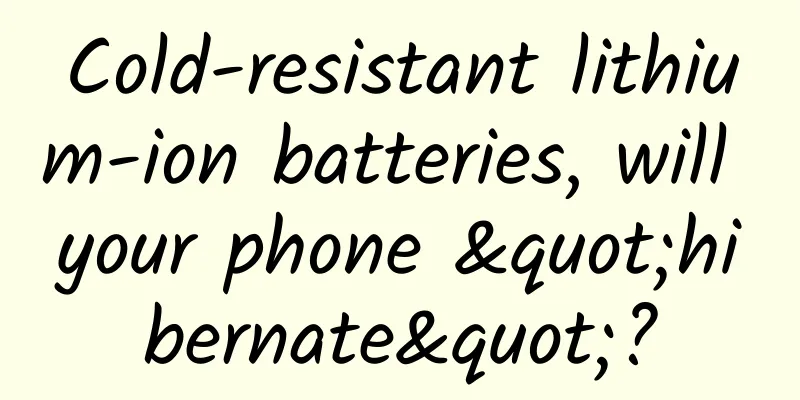Cold-resistant lithium-ion batteries, will your phone "hibernate"?

|
China Science and Technology News Network, December 30 (Xu Qiqi) Have you ever encountered this situation? In winter, you take your fully charged mobile phone out, but it runs out of power before you use it for a short time. This is because the chemical activity of lithium batteries will deteriorate in low temperature environments, and the amount of electricity that can be effectively used is lower than that in normal temperature environments. Recently, a research team composed of scientists from Tianjin University, Beijing Jiaotong University and the Chinese Academy of Sciences discovered a method to allow lithium-ion batteries to work stably in extremely cold environments. They can still be charged even at -35°C and can release nearly 100% of the battery power during the discharge process. Lithium battery is a secondary battery that mainly relies on the movement of lithium ions between the positive and negative electrodes to work. Secondary battery is rechargeable battery, also called storage battery. The main materials of lithium-ion battery are positive electrode, negative electrode, diaphragm and electrolyte, in addition to aluminum foil, copper foil, aluminum plastic film and so on. Lithium-ion batteries have the advantages of light weight, high voltage, high specific energy, fast charging, low self-discharge, long cycle life, good safety performance, etc. Currently, lithium-ion batteries are mainly used in electronic products, electric vehicles and aerospace electronic engineering. At the same time, lithium-ion batteries also have problems such as intolerance to overcharge, intolerance to over-discharge, possible short circuit, and capacity decay due to temperature, etc. Scientists are researching lithium-ion batteries that charge faster, are more cold-resistant, more heat-resistant, and have higher performance. In order to improve the performance of batteries in extremely cold conditions, scientists replaced the graphite anode in lithium-ion batteries with a cobalt-containing zeolite imidazolate framework, and the battery performance became better. Tests found that the anode with the replaced material can also be stably charged and discharged at a temperature of -20°C. When the temperature is slightly below freezing, the battery's storage capacity can reach 85.9% of that at normal room temperature. Even if the temperature drops to -35°C, the battery anode can be charged and release nearly 100% of the battery power. |
>>: Dots of Science | This is the rocket that helped Tianwen-1 land on Mars?
Recommend
How to effectively build a points system for Internet finance APPs?
Each product has its own characteristics and feat...
Amap launches new feature nationwide: Navigation voice prompts waterlogging points
According to the Central Meteorological Observato...
WeChat Moments Ads Launches oCPM, Let’s Take a Look at Its New Features
Performance advertisers often encounter this diff...
The growth rate of smart speakers has slowed down. Will Baidu's decision to let Xiaodu become independent create the next wealth-making myth?
Finally, Xiaodu took the first step towards indep...
First in China: Google Glass live broadcast surgery
The first Google Glass surgery teaching live broad...
How do novice bidders analyze keyword reports?
As a bidder, one of the must-do things every day ...
1 in 2 people is infected! The doctor asks you to check for Helicobacter pylori because he really wants to save you
In recent years, the term "Helicobacter pylo...
How much does it cost to invest in Yan'an Electric's mini program?
How much does it cost to attract investment throu...
2021, those immortal stars
Source: Guangming.com Editor: Wang Zimo Editor: W...
The “national heavy equipment” passed the acceptance inspection! The results of Qian Xuesen and Guo Yonghuai’s “strategic deployment” decades ago finally came to fruition
Recently, in the Huairou Science City in Beijing,...
To B trend, how to attract customers through content?
01 Definition 1.1 Definition of tool-type SaaS pr...
Ogilvy's internal training on advertising creativity
In "Creativity is just incomprehensible? In ...
2022 Latest Kaochong Wanci Winter Vacation Class
Introduction to the latest 2022 Kaochong Wanci wi...
For beginners with zero foundation, I give this super detailed summary of the UI self-study process
A few years ago, I wrote a long article about lea...
Douyin’s 7-day spiral FEED resonance superposition and continuous explosion gameplay, revealing the underlying logic of Douyin’s sales from 0 to 11 million in 30 days!
Douyin’s 7-day spiral feed resonance superpositio...









